If you have been following along for a while, it should come as no surprise to you that I love Japanese castles! If you’ve missed the articles and IG posts until now, you may have seen the running tally of how many I’ve been to on the home page for Kristen Abroad. There are so many Japanese castles to visit, where do you start? While there are many not in this category I’d also recommend, if you have limited time for Japanese castle exploration, you really should start with 12 original Japanese castles remaining.
- 現存12天守 Quick Japanese Lesson
- National Treasures, Important Cultural Properties, and Other titles
- Which is the oldest of the 12 original Japanese castles
- Where have all the castles gone?
- 12 Original Japanese Castles to visit and their keeps
- Stamp Rally
- 12 Original Japanese Castles Map
- Original Japanese Castles Hiking Courses
- Like this post? Pin it for later.
[Editor’s Note: This post was originally published in January of 2019 and has been updated for freshness, accuracy, and comprehensiveness.]
Disclosure: Kristenabroad.com is a participant in the Amazon Services LLC Associates Program and other affiliate programs. For some links to products or services in this article, I may earn a small commission by you using my link. The price for you is not affected.
現存12天守 Quick Japanese Lesson
While it’s time-consuming thanks to my level of Japanese, I love doing research in Japanese. Though I still owe a debt of gratitude to Wanikani and the Minna no Nihongo series, along with so many other Japanese resources ( including my Japanese sensei at conversation classes)!
The 12 original Japanese castles are actually referring to the original Japanese castle keeps which in Japanese are usually referred to as 現存12天守. And because Japanese fascinates me, you get a quick lesson ;).
- 天守 = Tenshu, or castle tower. This term refers to the main castle keep as in Japanese castle design there are normally other towers on the complex as well. It is also sometimes referred to as “天守閣” or tenshukaku.
- 現存 = Genzon or “existing”. While that is true, they ARE existing, the English makes that somewhat confusing as there are other “Existing” Japanese castles that have been more recently re-constructed.
That said, when you see “the existing 12 Japanese castle keeps”, in Japanese they are referring to the Edo-period and older castles.
National Treasures, Important Cultural Properties, and Other titles
Most of the 12 have multiple designated titles of importance. Japan likes lists of 3 and 100. They all are considered as part of the 100 finest castles of Japan but there’s more that make these the Japanese castles to visit.
We’ll start with world clout. Himeji Castle was designated as Japan’s first UNESCO World Heritage Site.
Nationwide, five of the 12 are considered National Treasures: Hakone, Himeji, Inuyama, Matsue, and Matsumoto. I like to call Inuyama the most pretentious of the bunch. In the other 11 castles, there is a reference to all 12 castles (usually in pictures lining the overhead of the lookout area of the castle). Inuyama? Just shows the five that are designated as National Treasures.
The other 7 are designated “only” as Important Cultural Properties. However, most all are part of the さくら名所100選 (100 Famous Sakura Places – there’s actually 134 locations, we like lists of 100 but they aren’t always exactly 100).
Which is the oldest of the 12 original Japanese castles
I think the funniest is that at least three of them claim “I’m the oldest” somewhere on their property. Keep a lookout for signs, the first one I was at that I saw “oldest” I was so excited. Then I saw it at another and was like, wait a second…
Inuyama is one of them. Hence back to my pretentious joke.
If you go solely by when they were originally made Bitchu-Matsuyama wins hands down with an 11th-century build. However, that was on a neighboring mountain and they moved it to its current location later. The keep itself, the important part of the “which is older” at Bitchu-Matsuyama is younger than the others.
You also have the matter that regardless of when they were originally built, most had at least some fire or damage from war over the years. If you factor in what and how much was rebuilt and when, it starts to get tricky. And of course, are we talking about the castle or the keep? Which is where I think the good majority comes from.
And Inuyama Castle has them on the keep initial construction start date (yes, you have to be that specific. The oldest castle that started construction on a Tuesday 😉 – I kid).
A general aside: I can’t imagine the amount of work it is to move so much material without the help of modern machines!
On the note of these castles being so old, this is definitely a situation you will need to take your shoes off in Japan for!
Where have all the castles gone?
There was a massive push to building Japanese castles in the late 1500s and early 1600s. I joke that they sent out carrier pigeons because the timing is creepily similar for the spread of land with no mass communication like today. You may have noticed while researching a trip in Japan that Japan is basically the size of the eastern seaboard of America.
There are estimated thousands of castles across Japan at that point. However, once the Tokugawa took over, there was a “一國一城令” or “one country, one castle order”. Lots of the 300 or so daimyo lords across Japan had to consolidate into one castle and the rest destroyed.
During the Meiji Period, there was a force in the works to get rid of all the castles as part of the Meiji restoration, otherwise, we’d have a lot more original Japanese Castles to visit.
廢城令, or terminate the castle’s decree. Seen as symbols of the old regime, most were dismantled. Some left just to degrade into disrepair. Many other original Japanese castles then succumbed to earthquakes or fires or wars. What we have left today is a testimony to those that stood up for keeping the heritage. Mostly local movements.
12 Original Japanese Castles to visit and their keeps
Here are the 12 original Japanese castles in alphabetical order, as to not cause contention. If you’ve followed my travels for a while, you know which I think are the best original Japanese castles. Click through to their individual posts for more information on each!
Bitchu Matsuyama Castle (備中松山城)
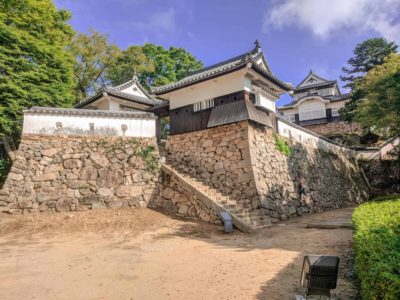
Bitchu-Matsuyama Castle (備中松山城) to not confuse it with the other Matsuyama castle in the list of original Japanese castles, this one is in Okayama Prefecture. It is the only one on top of a true mountain and the highest for that reason. Which makes the name even funnier as it’s a ***** to get to.
There’s no easy way to get to the top, even if you get dropped by a taxi you’ll still have a section of the mountain to hike up but it is beautiful when you do. If you are lucky you’ll be above the clouds!
Hikone Castle (彦根城)
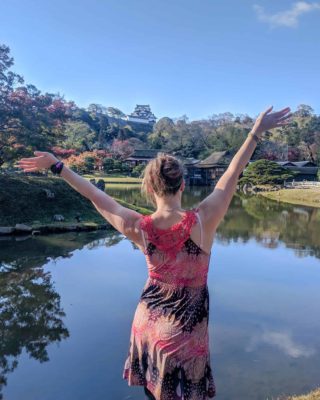
One of the national treasures, Hikone Castle (彦根城) is on the smaller side with only a three-tier donjon, however, I’d put it as my second favorite. Located in Shiga Prefecture. It has this beautiful garden and some unique features – like the fact it was made completely out of another near by castle. Talk about recycling!
It was on the docket to have been dismantled as part of the Meiji Restoration but was saved.
Himeji Castle (姫路城)
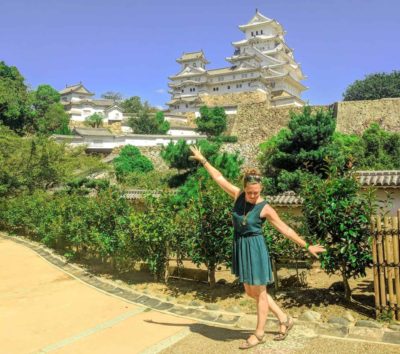
Considered the largest of the originals, and really, there shouldn’t be contention. Himeji Castle (姫路城) consists of some 83 buildings and the main keep is a giant 5 stories. Located in Himeji City in Hyogo Prefecture. She’s also one of the National Treasures.
You’ll need a fair amount of time to explore it all, while I’m probably the weirdo that doesn’t place this as number 1 it is still absolutely breathtaking and in my top 3. Luckily, getting to Himeji is super easy as it has its own shinkansen station
Hirosaki Castle (弘前城)
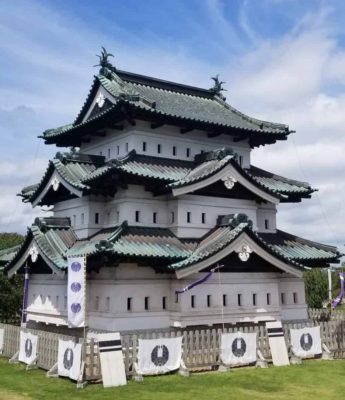
The farthest north of the original 12 Japanese castles to visit in Aomori Prefecture is Hirosaki Castle. It was originally called Takaoka Castle (there’s another one of those in the continuing list of 100 famous Japanese castles) with an original keep that was 5 stories tall that was burned in a fire.
Another of the Tokugawa’s rules was about the size of the keeps so when it was rebuilt, they were only allowed to rebuild a 3 story one. Hirosaki Castle (弘前城) is currently relocated to reinforce the walls. A feat in itself.
With Hirosaki Castle off by itself, you’ll definitely want to hit some of the local attractions as well. I love Aomori and Hirosaki is known for all things apples – fruit, pies, curry, random apple decorations, you name it!
Inuyama Castle (犬山城)
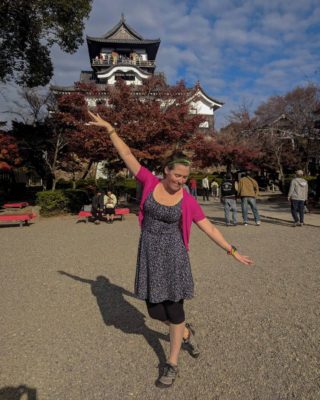
The aforementioned pretentious castle, Inuyama Castle (犬山城). One of the national treasures and self
Don’t miss the shopping street immediately in front of the castle entrance while you are here for some local food and omiyage (souvenir) shopping.
Kōchi Castle(高知城)
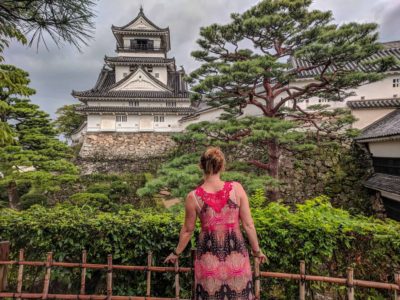
One of the newer of the 12 due to a fire that burnt her down. Kochi Castle (高知城) was still rebuilt before the “cut off” though. Kochi is the most southern prefecture in Shikoku. Unique to Kochi is that the palace is still remaining and one of the few instances where it was attached to the castle. In fact, ALL of the honmaru (1st bailey) is intact.
It’s honestly quite hard to rank the twelve against each other but this is one of my favorites. The town of Kochi has an interesting history of whale hunting so if that’s something you are against, be forewarned there is a display in a section of the castle for it.
Marugame Castle (丸亀城)
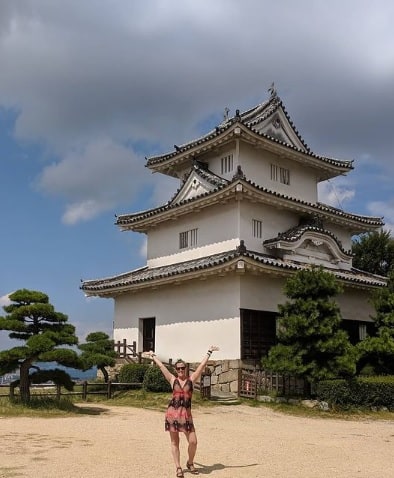
The smallest of the lot but Marugame Castle (丸亀城) still with character. Prepare for a steep hike up the hill to see the keep. Many of the original walls are still there and famous for the fan shapes. Located on the island of Shikoku in Kagawa Prefecture.
The view out to the sea from the top is pretty amazing. Just are the stone walls, at 60 meters high they are the tallest in Japan.
Maruoka Castle (丸岡城)
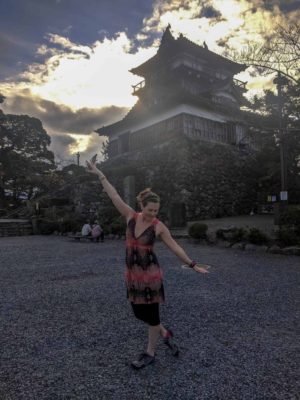
Located in Fukui Prefecture, Maruoka Castle (丸岡城) probably has the stretchiest claim to the 12 as it was nearly flattened in an earthquake during last century. However, they were able to jigsaw her back together with most of her same parts. She’s located in Fukui Prefecture.
Best part about that sketchy claim? She’s another one that claims to be the oldest Japanese castle. Don’t miss her neighboring Kasumigajo park garden, while new, they are still very nice and you can have a cup of green tea or some beer like I did while you enjoy the view.
Matsue Castle (松江城)
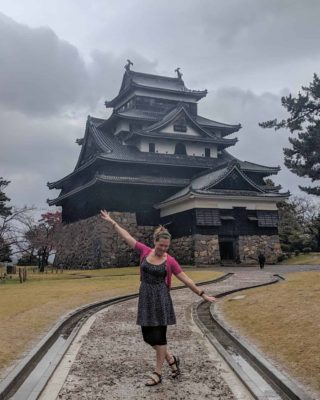
The 2nd largest (Matsumoto might fight her on that one), 3rd tallest, and 5th oldest, Matsue Castle (松江城) is also the farthest west on mainland Japan in Matsue, Shimane Prefecture.
Matsue and neighboring Tottori have so much to see (don’t miss the sand dunes, sand dune museum, and another of the 100 famous castles, Tottori Castle).
Matsumoto Castle (松本城)
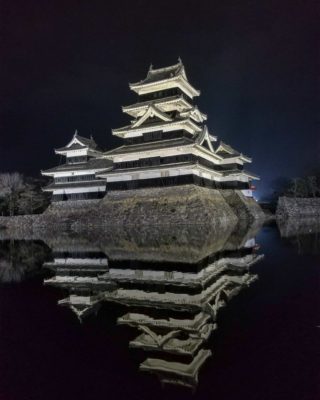
One of the five National Treasures. Matsumoto Castle (松本城) is also one of the contenders for t
Matsumoto Castle from the outside looks like 5 stories but on the inside it is actually 6. It also has the feature that it is multiple towers smushed next to each other. Nicknamed the “Crow castle” for its black exterior, its large moat makes for some spectacular photos.
Another town that you’ll want to spend some time walking around the city in. Lots of older buildings and some great beer to check out as well.
Matsuyama Castle (松山城)
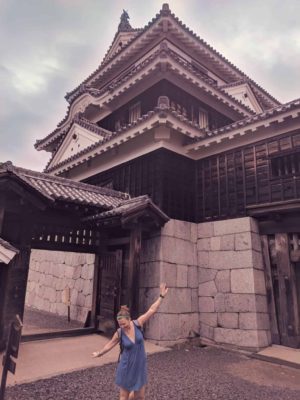
I know I said I wouldn’t mention my favorite, but this is it! Matsuyama Castle (松山城) takes the cake of any of them. Even Himeji which is probably the most widely known. Located on Shikoku in Ehime prefecture.
Fun fact: Ehime is the only Prefecture with more than one of the 12 original Japanese castles to visit.
Uwajima Castle (宇和島城)
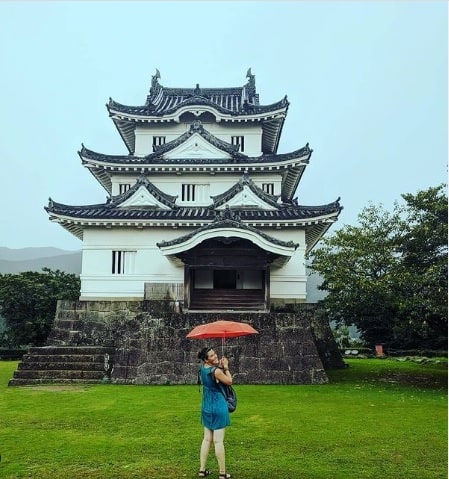
Uwajima Castle (宇和島城) is definitely a baby castle but worth the visit as it finishes out the 12! Located in Ehime Prefecture as well, but still, a bit of a ride from Matsuyama, especially if it is like when I went and hue amounts of rain had taken out part of the train tracks.
Stamp Rally
Don’t forget to get your guidebook to add these to your stamp rally for the 100 Finest Castles of Japan! The designation set by the Japan Castle Foundation in 2006 and further in 2017.

12 Original Japanese Castles Map
As you can see by the below map, you aren’t going to be hitting these all in one day! Frankly, I love how much they are spread out because it gives you the opportunity to see so much more of this beautiful country.
Original Japanese Castles Hiking Courses
It is super easy to get exercise in Japan with all the walking around you can do. Having such a great public transportation system (between the buses, trains, and shinkansen) helps that. But also the general “culture” of Japan. Case in point – hiking courses (we’d call them trails but it’s courses in Japan). Most all Japanese castles to visit have courses mapped out for you already. Or you can make your own with your fitness device, I love my Garmin Fenix 6s.
Not that you necessarily need an extra route to hike when some of these castles are massive! But if you are staying in a particular city for a few days, I’d suggest giving it a go, there are always beautiful views and random artifacts hidden around.
Like this post? Pin it for later.

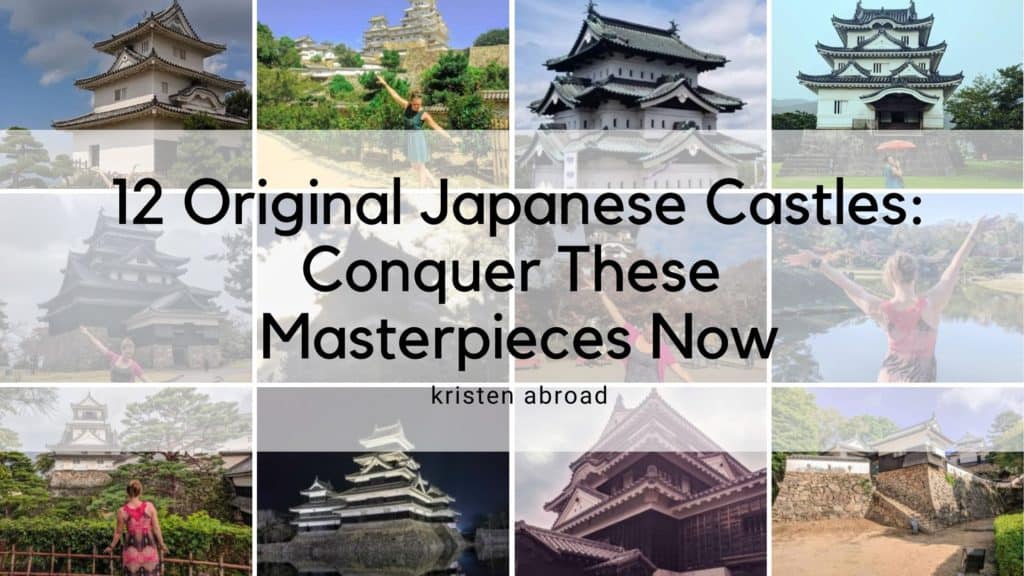
Love this article! I personally haven’t been to Japan yet but saw a few vlogs and they really got me intrigued to plan our trip there! I would absolutely love some good old road trip over to explore all the castles you mention that I’m not going to try to even pronounce! 😅 Btw love your website and how easy it is to navigate around too! 🙂